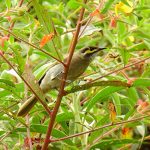YELLOW-FACED HONEYEATER
The Yellow-faced Honeyeater is a medium-sized bird, about 15 to 18 centimetres in length. It boasts a subtle yet striking appearance, with olive-brown feathers covering its back and wings. What truly sets it apart is the bright yellow stripe that runs across its face, from the beak to behind the eyes, giving it its name. This yellow stripe is bordered by a black line, adding a touch of elegance to its look. Its underparts are a soft greyish-white, blending harmoniously with the natural surroundings.
This honeyeater is a common sight along the eastern coast of Australia, ranging from northern Queensland down to Victoria and into South Australia. It thrives in a variety of habitats, including open forests, woodlands, and even suburban gardens. Its adaptability allows it to flourish in both coastal and mountainous regions, wherever flowering plants and trees are abundant.
The breeding season for the Yellow-faced Honeyeater typically occurs from July to January. During this time, they build cup-shaped nests in the fork of a tree or shrub, often using bark, grass, and spider webs to weave their home. The female usually lays two to three eggs, which she incubates for about two weeks. Both parents share the responsibility of feeding the chicks, ensuring their survival in the bustling bush.
While the exact lifespan of the Yellow-faced Honeyeater is not well-documented, many small honeyeaters can live for several years in the wild, often reaching around five to six years if they manage to avoid predators and harsh conditions.
As their name suggests, these birds have a penchant for nectar, which they extract from flowers using their specially adapted brush-tipped tongues. They play a crucial role in pollinating plants as they flit from bloom to bloom. However, their diet is not limited to nectar alone; they also consume insects and spiders, providing a balanced intake of protein and energy.
The call of the Yellow-faced Honeyeater is a series of clear, melodious notes, often described as a cheerful “chip-chip” or “chick-up” sound. Their song is a familiar and comforting melody in the Australian bush, especially during the early morning when the air is crisp and alive with birdsong.
The Yellow-faced Honeyeater is known for its incredible migratory behaviour. Each year, thousands of these birds embark on a journey from the southern parts of Australia to the north, following the flowering of eucalyptus trees. This migration is a spectacular sight, with flocks of honeyeaters travelling together in search of abundant food sources.
Despite their small size, they are bold and curious, often approaching humans in gardens, especially if nectar-rich flowers are available.

















